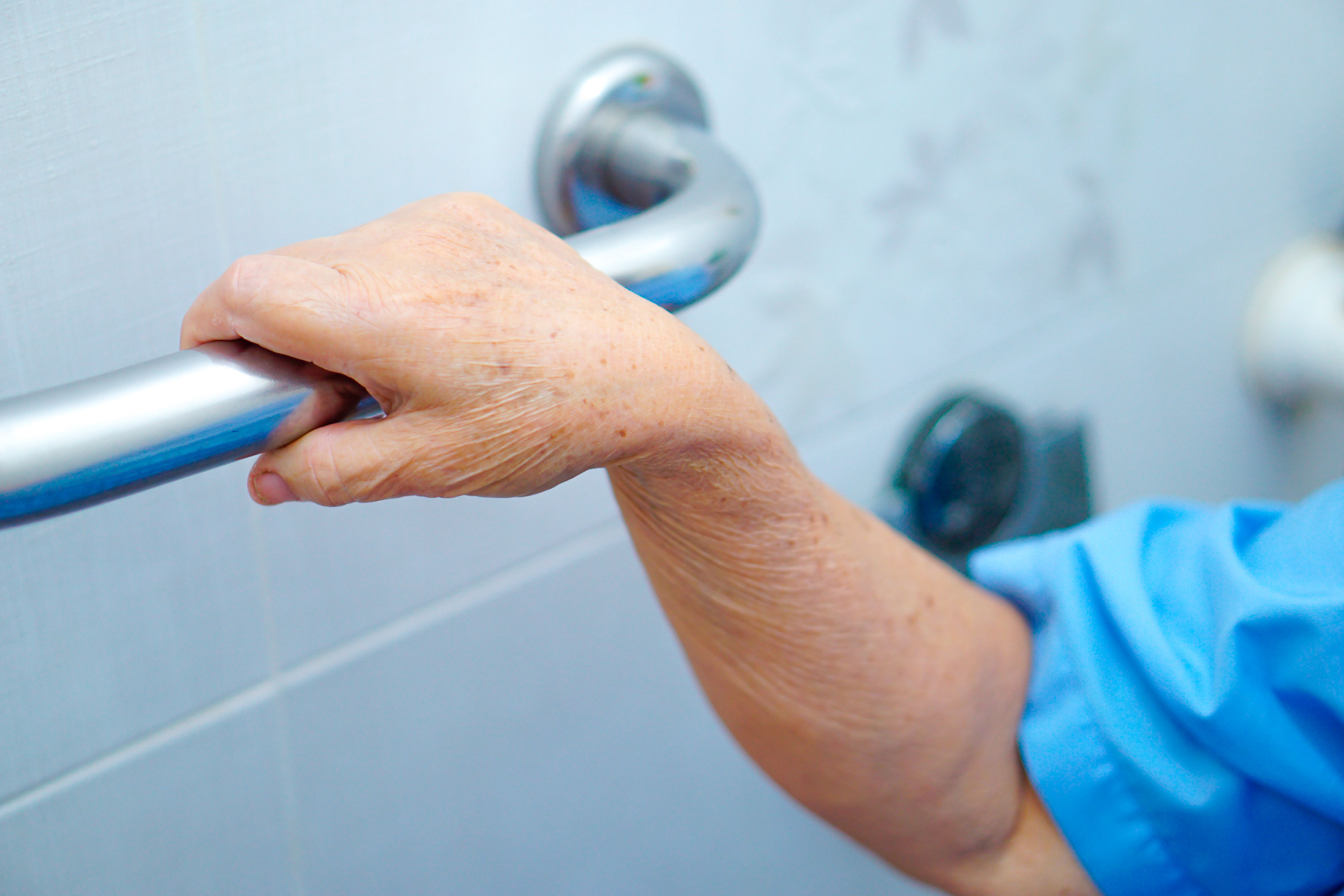Asset Publisher
Bathroom Safety for a Loved One with Late Stage Dementia
09/14/2020

An older adult holding onto a grab bar in a bathroom
These days, about 80 percent of people with Alzheimer’s disease and related dementias (ADRD) stay in their own homes with the support of family and friend caregivers rather than move to long-term care facilities. While aging in place can provide a loved one with a familiar, comforting space, it can also lead to challenges related to the safety of the home environment. Things around the house like stairwells, area rugs, medicine cabinets and knife blocks that were once a normal part of a loved one’s living space may now present new dangers with ADRD.
It may come as a surprise, but the most dangerous room in the house for older adults, especially those with ADRD, is the bathroom and not the kitchen. According to a CDC report, falls due to wet surfaces make up about 80 percent of bathroom-related injuries such as hip fractures, and adults 65 and older are the most likely to be injured and hospitalized because of accidents in the bathroom.
Bathrooms can also be a hotspot for germs, which is more worrisome than ever now that we are amid a pandemic. While public restrooms are far riskier than home bathrooms when it comes to germ exposure, if your loved one goes out in public or someone else uses their bathroom, dangerous germs may still spread on numerous surfaces.
To make the bathroom a safer environment for a loved one, we should consider:
1. Sanitizing regularly, especially commonly used surfaces in the bathroom like the door knob, light switch and faucet knobs. The CDC recommends wearing rubber gloves while cleaning, and cleaning surfaces with soap and water before disinfecting.
2. Hiring a professional contractor to help us make some adjustments.
3. Installing grab bars in the bathtub and by the toilet. While a loved one may try to grab onto a towel bar or hook for support, these are often not designed to handle force and may break, causing a loved one to fall and injure themselves. Grab bars are designed to hold a person’s weight and are much safer.
4. Placing non-skid strips on the tub bottom and having a non-skid rug or mat on the floor to prevent falls.
5. Installing an automatic faucet control on the bathroom and kitchen sinks. This inexpensive device screws right onto a loved one’s current faucet, and adds a small wand that descends from the faucet. If a loved one makes contact with that wand, it turns the water on. Once they move their hand away, it releases the pressure from the wand and shuts off the water. This will enable a loved one to run the water without having to grasp the hot and cold water knobs. Since it automatically turns off, we don’t have to worry about water being accidently left on where the sink could overflow and ruin carpets and floors.
6. Resetting the hot water heater to 120 degrees. We should do this to prevent a loved one for burning themselves in the shower. Although comfortable water temperature for showering is around 100 degrees, most home water heaters heat water up to 140-160 degrees. Scalding can occur when the water temperature is above 120 degrees. Due to thin skin, older adults are vulnerable to burns, and if they are in the advanced stages of ADRD, it may affect their ability to feel heat. They may not realize the water is too hot until the burn has occurred.
However, it’s important to note that turning the hot water heater down may decrease the effectiveness of dishwashers and washing machines. If this is a concern, we can hire a plumber to install a scald-protection device or go to our local hardware store and purchase one we can attach to the showerhead.
7. Removing mirrors in the bathroom. In the later stages of ADRD, a loved one may see “a stranger in the mirror” when they do not recognize their own reflection. This may startle our loved one and cause them to fall.
8. Taking inventory of the everyday toiletries in the bathroom and locking up items like rubbing alcohol, nail polish remover, soap, shampoo, perfume and any cleaning supplies. We can buy inexpensive, yet effective childproof locks for a bathroom cupboard or medicine cabinet that’s not safe for a loved one to access.
If we’re unsure of which risks are present in a loved one’s bathroom and the rest of their home, we can see if any organizations in our area offer home safety assessments, or else use self-assessment tools and checklists available online.
Related Assets
Suggested Reads
Identifying Risks and Preventing Falls for Older Adults
Winter weather can be beautiful, but along with the picturesque snow comes the less ideal increase to falls caused by ice and slush. While falls can be dangerous for people of all ages, they are a particular risk to older loved ones. According to the CDC Injur...
Keeping the Kitchen Safe for a Loved One with Late Stage Dementia
The kitchen is the heart of most families' homes. If we have a loved one living with dementia at home, especially in the later stages, we will want to do everything we can to help keep their kitchen as safe as it can be.
Practical Tips for Aging in Place with Mobility Aids
Aging in place with the support of mobility aids requires a holistic approach that encompasses understanding the challenges, selecting the right aids, making essential home modifications, creating a age-friendly living space, and utilizing caregiver assistance...
There's No Place Like Home: Creating Safe Environments for People With Late Stage Dementia
For someone with Alzheimer’s or another memory disorder, home may not always be the safest or most convenient place to live. As caregivers, we can help a loved one make modifications so they can continue to live safely in familiar surroundings.
